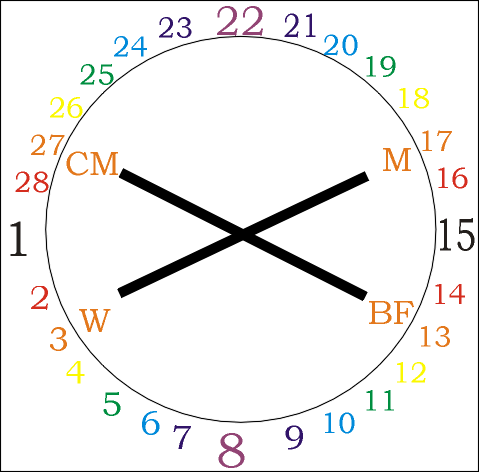
F: Dispersal
F: Pride
3 FCM
27 TM
| The attributes of the Faculties when Will is at Phase 3 | derived from | modified by | from | description | ||
| Will | Beginning of ambition | 3 | ||||
| Mask | True | Innocence | 17 | BF | 27 | Enforced loss |
| False | Folly | CM | 13 | Creative imagination through antithetical emotion | ||
| Creative Mind | True | Simplicity | 27 | BF | 17 | None except impersonal action |
| False | Abstraction | FCM | 3 | Pride | ||
| Body of Fate | Interest | 13 | ||||
| Composite of Faculties | |
|---|---|
| true | Beginning of ambition seeks to deliver simplicity, modified by impersonal action, from innocence, modified by enforced loss, with the help of interest. |
| false | Beginning of ambition is misdirected into abstraction, modified by pride, bringing folly, modified by creative imagination through antithetical emotion, separated from interest. |
 | Attributes of Phase 3 | affects | modifies | |
| Will | Beginning of ambition | 3 | - | |
| Mask | T:
Simplification through intensity
F: Dispersal | 17 | - | |
| Creative Mind | T:
Supersensual receptivity
F: Pride | 27 | 13 TM 3 FCM | |
| Body of Fate | Enforced love of another | 13 | 17 FCM 27 TM | |
See AV B 108-09 & 96.
Morris’s Birdalone (The Water of the Wondrous Isles), many pastoral types
Yeats’s description of the phase from A Vision | |
|
Out of phase and copying the opposite phase, he gives himself up to a kind of clodhopper folly, that keeps his intellect moving among conventional ideas with a sort of make-believe. Incapable of consecutive thought and of moral purpose, he lives miserably seeking to hold together some consistent plan of life, patching rags upon rags because that is expected of him, or out of egotism. If on the other hand he uses his Body of Fate to purify his Creative Mind of the Mask, if he is content to permit his senses and his subconscious nature to dominate his intellect, he takes delight in all that passes; but because he claims nothing of his own, chooses nothing, thinks that no one thing is better than another, he will not endure a pang because all passes. Almost without intellect, it is a phase of perfect bodily sanity, for, though the body is still in close contact with supersensual rhythm, it is no longer absorbed in that rhythm; eyes and ears are open; one instinct balances another; every season brings its delight.
Seen by lyrical poets, of whom so many have belonged to the fantastic Phase 17, the man of this phase becomes an Image where simplicity and intensity are united, he seems to move among yellowing corn or under overhanging grapes. He gave to Landor his shepherds and hamadryads, to Morris his Water of the Wondrous Isles, to Shelley his wandering lovers and sages, and to Theocritus all his flocks and pastures; and of what else did Bembo think when he cried, 'Would that I were a shepherd that I might look daily down upon Urbino'? Imagined in some antithetical mind, seasonal change and bodily sanity seem images of lasting passion and the body's beauty. (AV B 108-09) |
See a broader view of the Phase in the consideration of the Phase Triads.